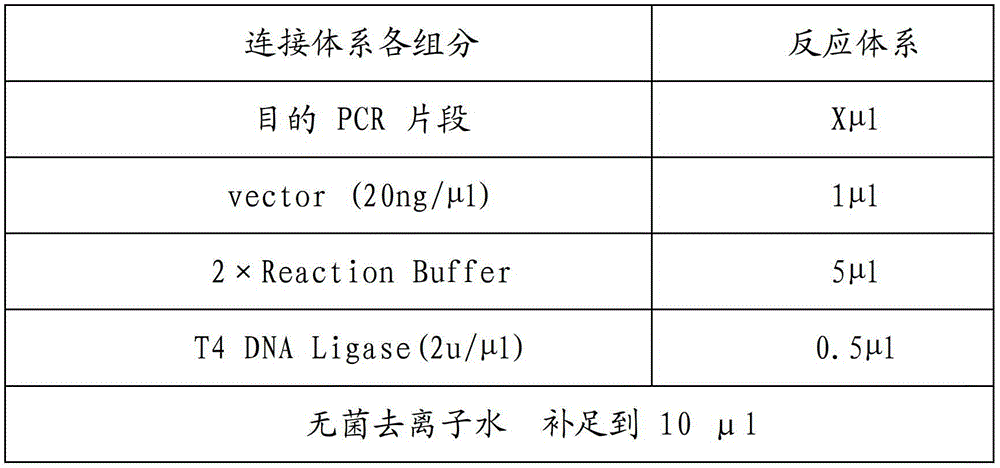A kind of multifunctional cloning carrier and its application method
A cloning vector and multi-functional technology, which can be used in the introduction of foreign genetic material using vectors, recombinant DNA technology, etc., can solve the problems of cumbersome steps and long time, and achieve the effect of low experimental cost, few experimental operation links, and improved scientific research efficiency.
- Summary
- Abstract
- Description
- Claims
- Application Information
AI Technical Summary
Problems solved by technology
Method used
Image
Examples
Embodiment 1
[0043] A kind of multifunctional cloning vector, its construction steps are as follows:
[0044] 1) Design a pair of primers with 5'-terminal phosphorylated sequences as follows:
[0045] F:5'-CTGTCAGACCAAGTTTACTCATA-3'
[0046] R:5'-TACCAATGCTTAATCAGTGAGGC-3'
[0047] The first base at the 5' end of the primer is A or G.
[0048] 2) PCR amplification
[0049] Using the PUC19 plasmid as a template, a high-fidelity enzyme PCR amplification was used to obtain a sufficient amount of product, and then the residual template plasmid was digested with DpnI endonuclease, and the product obtained by gel purification was a multifunctional cloning vector.
[0050] The PCR reaction system and conditions described therein are as follows:
[0051] The reaction system was designed as a total system of 50 μl, specifically 6 μl of 5×PCR Buffer (buffer), 2 μl of dNTPmix (deoxyribonucleoside triphosphate mixture) with a concentration of 2.5 mM, 1 μl of upstream and downstream primers with a ...
Embodiment 2
[0057] How to use the carrier:
[0058] 1 Primer Design Requirements
[0059] This vector has a preference for bases. When designing primers, make sure that the first base at the 5' end of the primers is A or G;
[0060] 2 The establishment of the reaction system
[0061] Add various components to a 0.2ml PCR tube according to the following reaction system:
[0062]
[0063] Gently flick the reaction tube to mix the contents and centrifuge briefly for 3-5 seconds;
[0064] 3 Put the mixed reaction solution at room temperature (22°C-30°C) to react for 5 minutes. After the reaction, put the reaction tube on ice and carry out the subsequent conversion reaction. If the length of the inserted fragment is greater than 2kb, the reaction time can be extended to 30 minutes;
[0065] 4 Conversion
[0066] 1) Take part of the ligation product and add it to 50-100 μl of competent cells (the competent cells just taken out of the refrigerator are placed in an ice bath for about 20 min...
Embodiment 3
[0072] Positive clone detection
[0073] a Rapid colony PCR detection
[0074] Pick colonies for direct PCR detection, and identify positive clones by PCR according to the following reaction conditions: pre-denaturation at 95°C for 3 min, denaturation at 94°C for 30s in the cycle, annealing at 55°C for 30s, 25 cycles, and extension at 72°C for Xs (1K / min) , Continue to extend at 72°C for 5min after PCR reaction cycle, and then store at 4°C;
[0075] b Sequencing identification: The DNA sequence is determined after the preliminary identification by the rapid colony method; the sequences of the PCR identification and sequencing primers of this vector are as follows:
[0076] F5'-AGACAGATCGCTGAGATAGG-3'
[0077] R5'-CGTTAAGGGATTTTGGTCATGAG-3'
[0078] The positive clones are more than 90%, the false positive rate is low, the experimental cost is low, and the experimental operation links are less than the traditional cloning method, which is convenient and fast.
PUM
 Login to View More
Login to View More Abstract
Description
Claims
Application Information
 Login to View More
Login to View More - R&D
- Intellectual Property
- Life Sciences
- Materials
- Tech Scout
- Unparalleled Data Quality
- Higher Quality Content
- 60% Fewer Hallucinations
Browse by: Latest US Patents, China's latest patents, Technical Efficacy Thesaurus, Application Domain, Technology Topic, Popular Technical Reports.
© 2025 PatSnap. All rights reserved.Legal|Privacy policy|Modern Slavery Act Transparency Statement|Sitemap|About US| Contact US: help@patsnap.com

